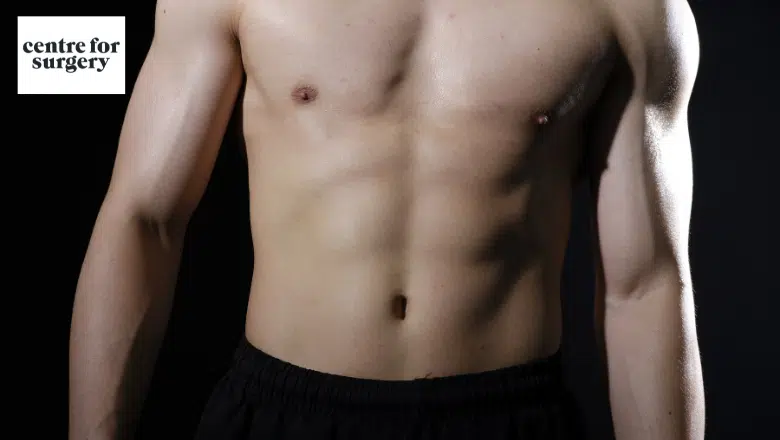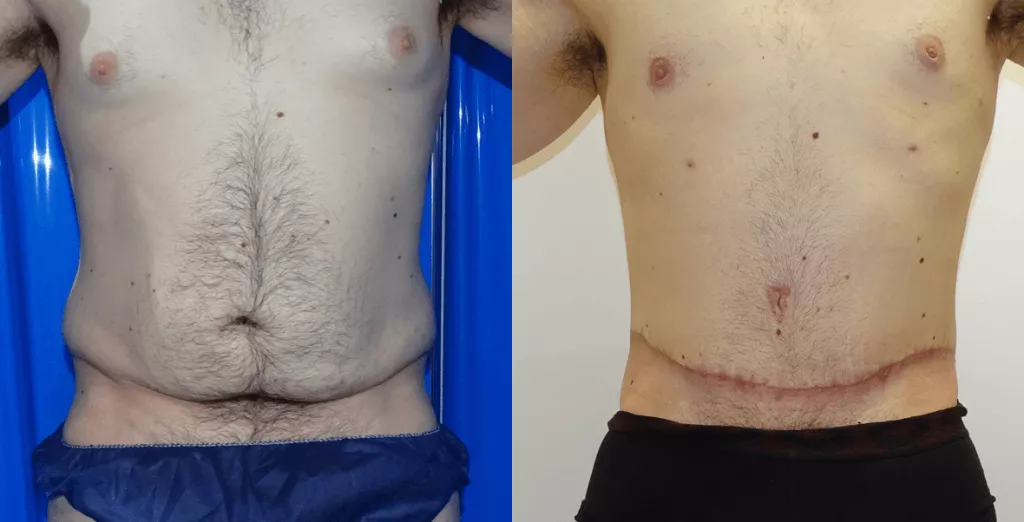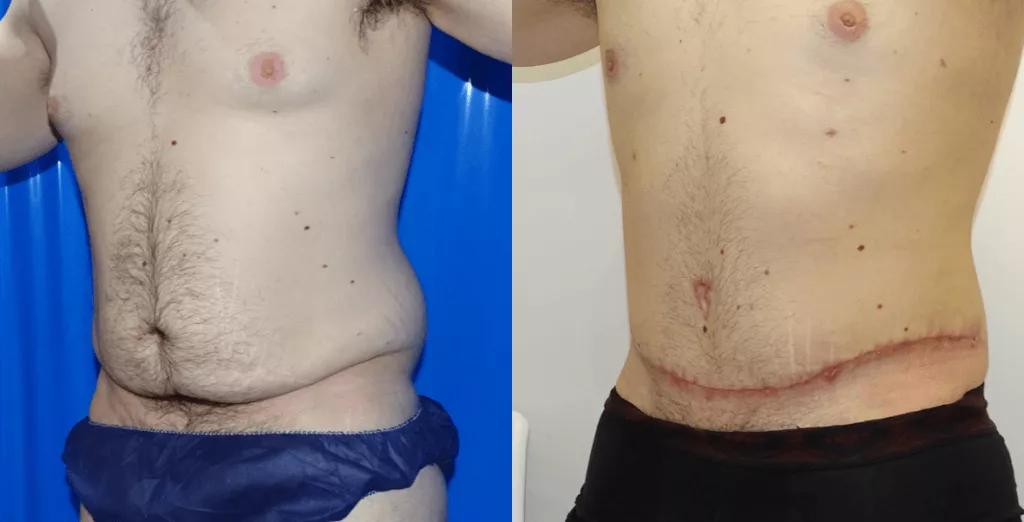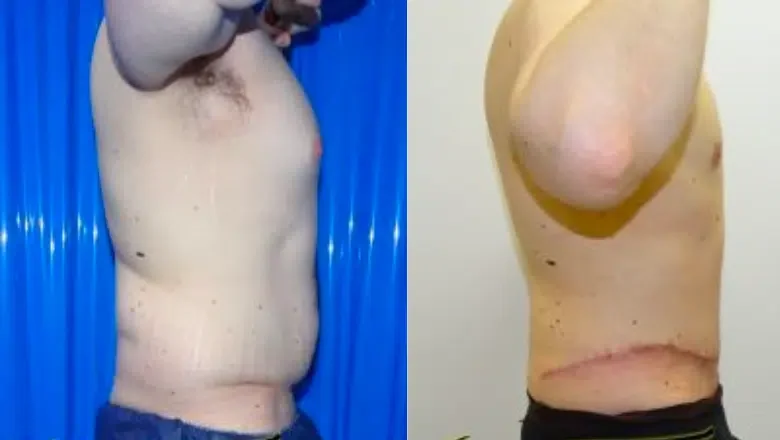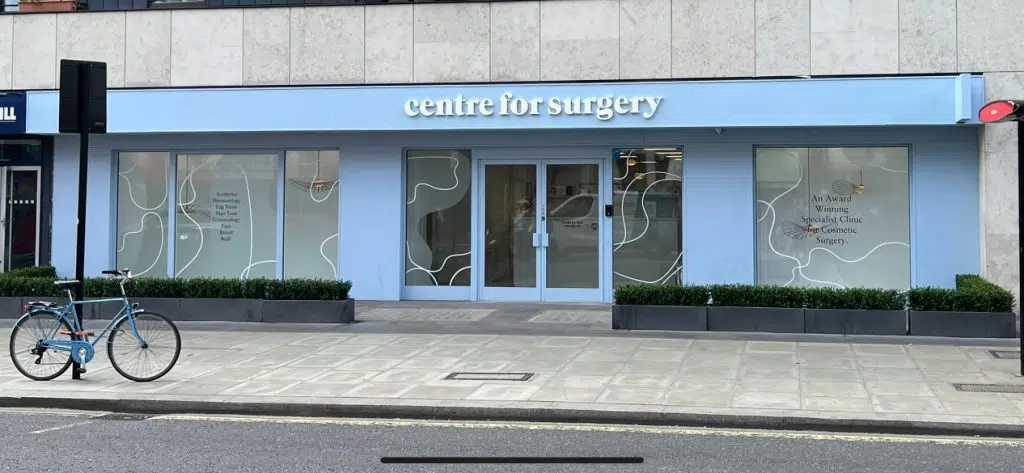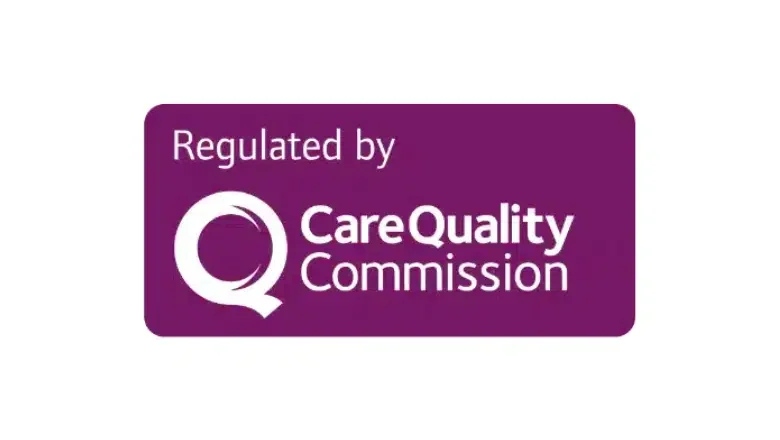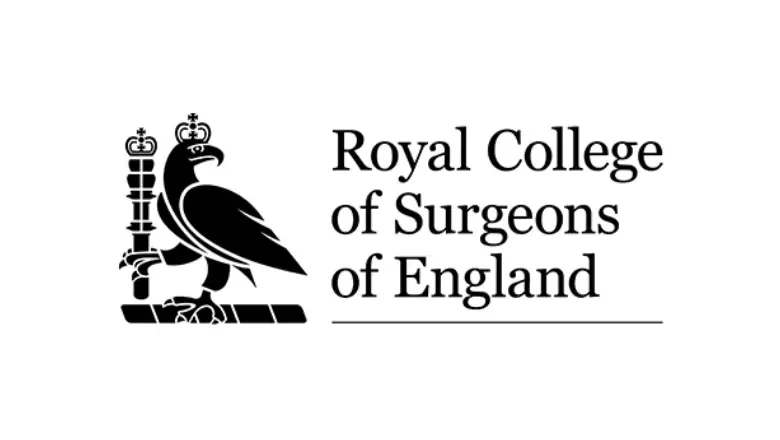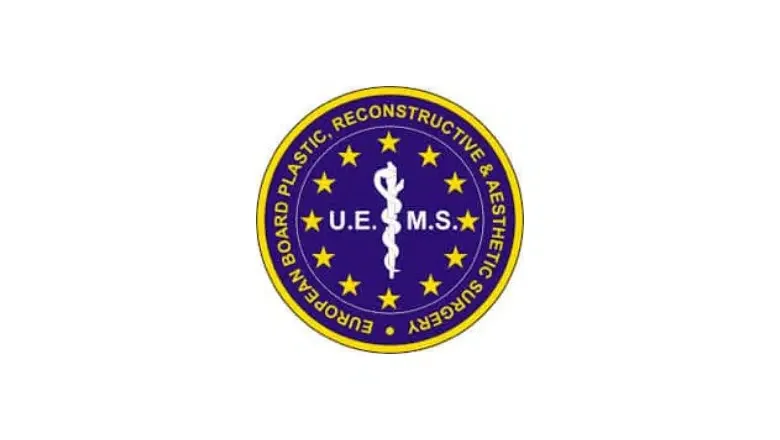Tummy Tuck for Men in London
Transform your physique with a male abdominoplasty – expertly tailored to restore confidence and reveal a flatter, firmer abdomen
Male abdominoplasty, also known as a male tummy tuck, is a highly effective body contouring procedure for men who would like to achieve a flatter stomach without loose skin or excess fat. A full abdominoplasty involves the removal of excess skin with the sculpting of the abdomen using liposuction to result in a firmer-looking abdomen with a better tone. Men often develop a significant boost in self-confidence as a result of having a male tummy tuck and can look forward to wearing an unrestricted range of clothing, including swimwear and beachwear.
RELATED: Male Body Contouring
At Centre for Surgery, we specialise in Brazilian abdominoplasty, a combination of liposuction and a full tummy tuck to get rid of loose skin and fat and tighten the abdomen using the most advanced surgical techniques. Abdominoplasty for men is ideal for the removal of excess skin on the tummy that has proven resistant to regular physical exercise and a sensible diet.
RELATED: What Does A Daddy Makeover Include?
What Is a Tummy Tuck for Men?
A male tummy tuck, commonly known as abdominoplasty, is a surgical solution designed to address the concerns of men who are dealing with an overhanging belly or an excess of loose skin around their midsection. This cosmetic surgery procedure not only eliminates unwanted fat deposits and sagging skin but also refines the overall appearance, contour, and firmness of the abdominal area. In addition, a male tummy tuck has the potential to tighten the underlying abdominal muscles, further enhancing the desired aesthetic results.
For those men who are struggling with excess skin and fat not only in their abdominal region but also extending to their flanks and hips, an alternative surgical option might be more suitable. In such cases, an extended tummy tuck or circumferential tummy tuck, performed by a skilled body lift surgeon, could provide more comprehensive results. These specialised procedures are designed to address a larger area of the body, ultimately offering a more harmonious and balanced outcome tailored to the patient’s unique needs and goals.
Male Abdominoplasty Before & After Photos - Real Patient Results
This patient had 360 liposuction of the abdomen and flanks, extended abdominoplasty with muscle repair and gynecomastia removal with liposuction and gland excision.
What Are The Benefits Of Male Tummy Tuck ?
Most men who choose to have an abdominoplasty often do so because of significant weight loss, which results in the following problems:
Excess loose and sagging skin
This can be effectively treated by excess surgical skin removal
Areas of excessive subcutaneous fat
Men may often develop an uneven distribution of abdominal fat which can often look very unsightly but is effectively treated with liposuction.
Severe skin laxity
Men who have lost large amounts of weight may notice the development of redundant skin folds.
Stretch marks or striae
Stretchmarks commonly develop after weight loss and can be surgically removed with abdominoplasty or nonsurgically with Morpheus8 treatment.
Abdominal muscle weakness
Excessive weight gain often results in bulging of the abdominal muscles, which do not return to normal after significant weight loss. A male abdominoplasty can effectively repair the weakened muscles leading to a flatter and firmer abdomen.
RELATED: What is the difference between liposuction and a tummy tuck?
Although a full abdominoplasty is most commonly carried out in men, some men may be suitable for a mini-abdominoplasty (min tummy tuck). This procedure involves the removal of excess skin and subcutaneous fat in the lower half of the abdomen. The procedure is commonly combined with liposuction to remove areas of prominent fat to give the best tummy tuck results. Mini tummy tuck recovery is quicker than a full abdominoplasty, with patients requiring no more than one week away from work. The minimally invasive nature of a mini-abdominoplasty means patients can carry out nonstrenuous work activities after 2 to 3 days. Most patients can commence light activities after 7 to 10 days and resume going to the gym after six weeks.
Am I suitable for Male Abdominoplasty?
You may be an ideal candidate for a male tummy tuck if you’ve gone through significant weight changes in the past, which have altered the look of your abdomen. If you have a belly that hangs like an apron, often due to these weight fluctuations, and you’re unhappy with its shape or contour, this procedure could be right for you.
It’s common to feel self-conscious or lack confidence because of the appearance of your abdomen, which might even affect your relationships and intimacy. You might avoid social situations out of embarrassment about how your stomach looks. Even after successfully losing a large amount of weight, you may still struggle with loose skin or stubborn fat around your abdomen.
Being a non-smoker, or willing to stop smoking for at least 6-8 weeks before and after the surgery, is important because smoking can hinder your recovery. Additionally, you should be committed to maintaining a healthy diet and stable weight after the procedure. If you already exercise regularly and focus on toning but are looking for further refinement to achieve a more athletic or sculpted look, a tummy tuck might provide the enhancement you seek.
Different Types of Tummy Tucks for Men
There are several different types of tummy tuck procedures that cater to the specific needs and goals of male patients. Each type of abdominoplasty is designed to address different areas of concern and degrees of excess skin and fat. Here is an overview of the most common types of male tummy tucks:
Mini Tummy Tuck
This procedure is ideal for men who have a moderate amount of excess skin and fat in the lower abdomen. The mini tummy tuck involves a smaller incision and focuses primarily on the area below the belly button, resulting in a shorter recovery time and less scarring.
Full Tummy Tuck
A full tummy tuck, also known as a standard or complete male abdominoplasty, addresses excess skin and fat in the entire abdominal region. This procedure involves a larger incision that extends from hip to hip and around the belly button. The full tummy tuck is suitable for men who have more significant concerns about their abdominal area and may also include tightening of the underlying abdominal muscles.
Extended Tummy Tuck
This procedure is designed for men who have excess skin and fat extending beyond the abdominal area to the flanks and hips. An extended tummy tuck involves a more extensive incision than a full tummy tuck and allows the surgeon to remove the additional unwanted tissue and contour the surrounding areas for a more harmonious result.
Fleur-de-Lis Tummy Tuck
This specialised procedure is ideal for men who have a considerable amount of excess skin and fat in both the upper and lower abdominal regions. The fleur-de-lis tummy tuck involves a vertical incision in addition to the horizontal incision of a standard tummy tuck. This allows the surgeon to remove excess tissue and tighten the abdominal muscles in both the vertical and horizontal planes, resulting in a more defined and sculpted appearance.
Circumferential Tummy Tuck
Also known as a body lift or belt lipectomy, the circumferential tummy tuck is a comprehensive approach that addresses excess skin and fat in the entire midsection, including the front, sides, and back. This procedure is often recommended for men who have experienced significant weight loss and have excess skin around their entire torso. The circumferential tummy tuck involves an incision that encircles the body, allowing the surgeon to remove excess tissue and create a more balanced and contoured appearance.
Male Tummy Tuck Procedure
Upon entering the surgical theatre for a tummy tuck procedure, a detailed and methodical process will be followed to ensure the best possible results. The entire procedure can take anywhere from two to five hours, depending on the extent of the surgery and the type of tummy tuck being performed. Here is a more in-depth look at the steps involved in an abdominoplasty:
Anaesthesia
To begin, you will be administered general anaesthesia to ensure your comfort and safety throughout the procedure. This will render you unconscious and unable to feel pain during the surgery. In some cases, intravenous sedation may be used instead of general anaesthesia, but this decision is based on your specific needs and the surgeon’s recommendation.
Incision
Once the anaesthesia has taken effect, the surgeon will make a carefully planned incision in the lower abdomen. The exact placement and length of the incision will depend on the type of tummy tuck being performed and the degree of correction needed. In a standard tummy tuck, the incision typically extends from hip to hip, just above the pubic area.
Lifting the Skin
After the incision is made, the surgeon will carefully lift the skin and fatty tissue away from the underlying abdominal muscles. This allows for better access to the muscles and provides the opportunity to remove any excess fat using liposuction, if necessary.
Tightening the Abdominal Muscles
One of the primary goals of a tummy tuck is to tighten and repair weakened or separated abdominal muscles, a condition known as diastasis recti. The surgeon will use sutures to stitch the muscles together, effectively creating a tighter and flatter abdominal wall. This step is crucial for achieving a more toned and contoured appearance.
Removing Excess Fat and Tissue
With the abdominal muscles tightened, the surgeon will then remove any extra fatty tissues using liposuction or direct excision. This step helps to further sculpt the abdomen and create a more defined shape.
Repositioning the Belly Button
Due to the skin being lifted and tightened, the original position of the belly button may no longer be appropriate. In this case, the surgeon will create a new opening for the belly button and carefully suture it in place, ensuring that it looks natural and proportional to the new abdominal contour.
Stretching and Trimming Excess Skin
Once the underlying structures have been addressed, the surgeon will stretch the skin downward to smooth and tighten it. Any excess skin will be trimmed away, and the remaining skin will be sutured in place along the initial incision line.
Closing the Incision
Finally, the incision will be meticulously closed using sutures, skin adhesives, or surgical tape. The surgeon will ensure that the incision is as discreet as possible, allowing for minimal scarring and an aesthetically pleasing result.
Postoperative Care
After the surgery is complete, you will be taken to a recovery room, where you will be closely monitored as the anaesthesia wears off. Your surgeon will provide you with detailed postoperative care instructions, including information on pain management, wound care, and activity restrictions, to ensure a smooth and successful recovery.
Recovery After Male Tummy Tuck
In the initial days following your tummy tuck surgery, it is normal to experience some discomfort, tightness, and swelling in the abdominal area. These postoperative symptoms are to be expected and will gradually subside as your body heals. Your specialist plastic surgeon will take steps to minimise your discomfort and manage the swelling during this period. Here is an overview of the recovery process and what you can expect:
Pain Management
To alleviate any pain or discomfort, your surgeon will prescribe pain relievers that you should take as directed. It is important to stay on top of your medication schedule, as this will help you maintain a more comfortable recovery.
Compression Garments
You will be instructed to wear a specially designed compression garment around your abdomen. This garment provides support and helps to reduce swelling by applying gentle, consistent pressure to the area. It is crucial to wear the garment as recommended by your surgeon for optimal healing and results.
Gradual Resumption of Physical Activity
As your recovery progresses, you can slowly reintroduce physical activity into your daily routine. Gentle walking is encouraged within the first week, as it promotes blood circulation and can aid in the healing process. Gradually increase the intensity of your activities over the following weeks, as tolerated and advised by your surgeon.
Avoiding Strenuous Activities
For the first six weeks post-op, it is important to avoid heavy lifting and particularly exhausting activities. These activities can put undue strain on the healing tissues and may compromise your results. Your surgeon will provide guidance on when it is safe to resume these types of activities.
Regular Follow-Up Appointments
Attend all scheduled follow-up appointments with your tummy tuck surgeon. These appointments allow your surgeon to monitor your progress and address any concerns or complications that may arise during your recovery. It is essential to keep an open line of communication with your surgeon and follow their advice to achieve the best possible results.
Individualised Guidance
Remember that each patient’s recovery process is unique, and your surgeon will provide personalised recommendations based on your individual circumstances. Be sure to consult with your surgeon regarding any specific details or concerns you may have during your recovery.
The Risks of Tummy Tuck for Men
Male Tummy Tuck Costs & Prices – How Much Is Tummy Tuck In London?
Male abdominoplasty cost will depend on a number of factors, including body mass index and the type of tummy tuck to be performed. Extended abdominoplasty or Fleur-De-Lis abdominoplasty are more advanced types of tummy tuck that are suitable for men with severe skin laxity. These procedures will cost more. The average price for a male abdominoplasty starts from £9000, and if combined with liposuction, then the cost of the procedure will increase. If you would like an accurate quotation for a male abdominoplasty, please contact us today for a face-to-face consultation. Once you have had your consultation, your dedicated patient coordinator will give you a comprehensive quotation for the full breakdown of the costs involved for a male tummy tuck.
SEE ALSO: Cost of Male Tummy Tuck in London
What is included in the cost of the male abdominoplasty procedure?
- In-depth consultation with an expert male abdominoplasty surgeon
- Detailed face-to-face nurse-led preoperative assessment
- 24/7 emergency helpline for any questions or concerns you may have
- Your own dedicated patient coordinator to act as a point of contact throughout your journey with us at Centre for Surgery
- Complimentary nurse and surgeon appointments for up to 1 year after your procedure
- Your procedure will take place at our leading specialist cosmetic surgery clinic in London, located on Baker Street
Procedures commonly Combined with Male Tummy Tuck
Combining procedures with a male tummy tuck can enhance overall results and achieve a more comprehensive body transformation. Some common procedures often combined with a male tummy tuck include:
Liposuction
To remove excess fat from areas such as the flanks, hips, lower back, or chest, providing a more sculpted and contoured appearance.
Gynecomastia surgery (male breast reduction)
Addresses excess breast tissue in men, resulting in a flatter, firmer chest that complements the improved abdominal area.
Lower body lift
Addresses excess skin and sagging tissues in the buttocks, hips, and thighs, creating a more streamlined and toned lower body appearance.
Arm lift (Brachioplasty)
Tightens and reshapes the upper arms by removing excess skin and fat, resulting in a more toned appearance.
Thigh lift
Removes excess skin and fat from the inner or outer thighs, improving their shape and contour.
Panniculectomy
Removes the excess skin and fatty tissue (pannus) that hangs below the waistline, often a result of significant weight loss.
Hernia repair
Sometimes, a hernia may be discovered during the tummy tuck consultation or surgery. Combining hernia repair with a tummy tuck can address both issues simultaneously.
Combining procedures may increase operative time and recovery duration, but it can also offer the benefit of a single recovery period for multiple procedures, reducing overall downtime.
Is a Male Tummy Tuck Worth It?
When searching for the best tummy tuck surgeon in London, it is essential to prioritise safety, quality, and experience over cost. While some overseas surgeons might offer lower prices, these could come at the expense of quality care and safety standards. The same applies to the UK, so thorough research is crucial before choosing a surgeon for your tummy tuck procedure.
To identify a reputable and qualified surgeon, consider the following factors:
Specialist Certification
Ensure that the surgeon is a Specialist Plastic Surgeon and a member of recognised professional organisations, such as the British Association of Aesthetic Plastic Surgeons (BAAPS) or the British Association of Plastic, Reconstructive and Aesthetic Surgeons (BAPRAS).
Experience
Select a surgeon who specialises in tummy tuck procedures and has extensive experience performing them. An experienced surgeon is more likely to achieve optimal results and minimise potential complications.
Patient Reviews
Read testimonials and reviews from previous patients to gain insight into their experiences with the surgeon. This can help you gauge the surgeon’s level of expertise, bedside manner, and overall patient satisfaction.
Before-and-After Photos
Examine the surgeon’s portfolio of before-and-after photos to evaluate their work and ensure that their aesthetic approach aligns with your desired outcome.
Consultation
Schedule a consultation with the surgeon to discuss your goals, expectations, and concerns. Use this opportunity to assess their communication style, professionalism, and willingness to address your questions.
RELATED: Is a Male Tummy Tuck Worth It?
Male Abdominoplasty at Centre for Surgery
We pride ourselves on providing a comprehensive, patient-centred approach to male tummy tuck procedures. Here are several reasons to consider us for your male abdominoplasty:
Experienced and Certified Surgeons
Our plastic surgeons are highly skilled and have extensive experience performing male tummy tucks. They are dedicated to achieving optimal results while prioritising patient safety and well-being.
Personalised Care
We believe that every patient is unique and deserves a customised treatment plan tailored to their individual goals and expectations. Our surgeons work closely with patients to understand their needs and develop a surgical plan that will provide the best possible outcome.
State-of-the-Art Facilities
Our surgical centre on Baker Street is equipped with the latest technology and adheres to the highest safety and cleanliness standards. This ensures that our patients receive the best possible care in a comfortable and secure environment.
Comprehensive Consultation
Our thorough consultation process ensures that patients are well-informed about their procedure, potential risks, and expected outcomes. We encourage open communication and provide ample time for patients to ask questions and address any concerns.
Exceptional Support Staff
Our dedicated nurses, anesthetists, and support staff are committed to providing the highest level of care throughout the surgical journey, from the initial consultation to postoperative follow-up appointments.
Patient Satisfaction
We are proud of our track record of excellent patient satisfaction, a testament to our commitment to providing outstanding care and results.
One-Stop-Shop
In addition to male tummy tucks, we offer a comprehensive range of cosmetic and reconstructive procedures, allowing patients to address multiple concerns under one roof.
FAQs
-
Can a male tummy tuck provide a flat stomach?A tummy tuck has the potential to be a transformative surgical procedure that removes excess fat and skin, resulting in a flatter abdomen and tighter abdominal muscles. It can indeed provide a more toned and contoured stomach for many patients.
-
Is it possible to gain belly fat after a tummy tuck for men?Yes, gaining belly fat after a tummy tuck is possible. While the procedure removes some fat tissue, it does not eliminate all fat cells, which can still expand in volume if weight is gained after the surgery.
-
What is the minimum age requirement for a tummy tuck?There is no specific age requirement for undergoing a tummy tuck procedure. However, younger patients should be aware that the results may not be permanent, as significant weight fluctuations can cause the return of a saggy belly and loose skin.
-
What should a patient's BMI be for a men's tummy tuck?The optimal BMI range for a male tummy tuck is up to 30, although a surgeon may consider performing the procedure on a patient with a BMI as high as 35. For those with a BMI above 35, weight loss surgery, such as a gastric sleeve, may be a more suitable option.
-
What is the recommended weight for undergoing a male tummy tuck?A tummy tuck should not be considered a weight loss substitute or a replacement for healthy eating and exercise habits. Typically, plastic surgeons recommend that patients be within 5-10 kilograms (11-22 pounds) of their ideal weight before undergoing the procedure.
-
How much weight can be lost with a tummy tuck for men?A tummy tuck is not primarily intended for weight loss, and patients should expect to lose only around 3 to 5 kilograms (6.6 to 11 pounds) with the procedure. However, more weight can sometimes be removed with an extended tummy tuck or a 360-degree tummy tuck, especially when combined with liposuction or other body contouring procedures like arm or thigh lifts.
-
Which is more suitable: male abdominoplasty or liposuction?The choice between a tummy tuck and liposuction depends on the patient's individual goals, the amount of excess fat, and the quality of the abdominal skin. Liposuction is best suited for removing smaller amounts of fat from specific areas and does not address excess skin. In contrast, a tummy tuck removes both fat deposits and excess skin while also tightening the abdominal muscles.
-
What is the pain level associated with an abdominoplasty for men?Pain and discomfort levels following an abdominoplasty can vary depending on individual factors, including genetic predispositions. Generally, the first week post-surgery may involve higher levels of discomfort, which typically improve significantly by the second week. Your plastic surgeon can recommend appropriate pain relief options to manage any discomfort during the recovery period.
-
What is the typical recovery time after a tummy tuck for men?Recovery times can vary for each individual, but generally, patients should expect to wear a compression garment or binder for at least six weeks after the surgery to minimise fluid buildup and swelling. During this period, it is crucial to avoid strenuous activities, heavy lifting, and any other activities that could stress the healing tissues or sutures, as well as overly exerting the abdominal muscles.
-
How long will it take to stand upright after a tummy tuck for men?Experiencing tightness and discomfort in the abdominal area, making it difficult to stand completely upright without discomfort, is normal during the first few days following a tummy tuck. This sensation should gradually subside as the body heals and adjusts to the changes made during the surgery. Patients can expect to see improvement in their posture within the first week or two postoperatively.
Following your surgeon's recommendations and gradually increasing your physical activity is essential to help regain your normal posture and alleviate any lingering tightness.
During the recovery process, it's crucial to communicate with your surgeon and attend all scheduled follow-up appointments to ensure optimal healing and address any concerns or complications that may arise. Your surgeon may recommend specific exercises or stretches to help improve your posture and mobility during the recovery period.
What To Expect
Consultation
Embarking on a cosmetic surgery journey can be both exciting and daunting. To ensure you are fully informed and comfortable every step of the way, your dedicated patient coordinator will arrange an in-depth, face-to-face consultation with your surgeon at our renowned cosmetic surgery centre. This meeting is an invaluable opportunity to voice your concerns, explore surgical possibilities, and clarify the outcomes you envision.
Typically lasting between 30 to 60 minutes, this consultation is a chance for your surgeon to provide a detailed explanation of the most suitable options tailored to address your specific concerns and the achievable results. It's a proactive step to jot down any questions or thoughts beforehand. This preparation will help you to fully engage in the discussion, ensuring you extract maximum benefit from your time with the surgeon.
During this crucial meeting, your surgeon will delve into your medical history to understand any underlying conditions that could influence surgical outcomes. They will also perform necessary measurements and take photographs for your medical records, maintaining a comprehensive account of your journey.
After your consultation, your surgeon will meticulously prepare a personalised treatment plan, which will then be forwarded to your patient advisor. Subsequently, your advisor will reach out to you to review the proposed surgical options, discuss pricing details, and explore the earliest dates for potential procedures. Importantly, you will be given a mandatory two-week cooling-off period. This time is designed for you to thoughtfully consider the information provided, ensuring you make a decision that feels right for you regarding proceeding with surgery.
Preparation for Surgery
Embarking on the journey of male abdominoplasty, commonly referred to as a Tummy Tuck, requires meticulous preparation to ensure the safest and most effective outcome. Following your decision to proceed with this transformative procedure, your surgical team will guide you through a series of preparatory steps. These steps are designed to optimise your physical and mental readiness for surgery, paving the way for a smooth recovery and the best possible results.
First and foremost, you will be required to complete comprehensive pre-operative medical and psychological questionnaires. The insights gathered from these questionnaires allow your surgeon, anaesthetist, and nursing team to fully understand your health status and psychological readiness, ensuring you are well-prepared for the procedure.
A crucial aspect of your preparation involves abstaining from smoking and vaping at least six weeks prior to your surgery. This is because nicotine significantly hampers the body's healing capabilities, thereby affecting your recovery process. Similarly, it is imperative to eliminate alcohol consumption 48 hours before your surgery to prevent any adverse effects on your surgical outcome.
Additionally, you are advised to refrain from taking any anti-inflammatory medications, such as ibuprofen and aspirin, as well as herbal supplements for a week before your surgery. These substances can increase the risk of bleeding, complicating both the procedure and your recovery.
Ensuring you have a reliable support system post-surgery is equally important. You must arrange for a trusted family member or friend to collect you from the clinic after your operation. This individual should be able to drive you home or accompany you in a taxi and provide support during the critical first night of your recovery.
Dietary restrictions play a pivotal role in your pre-surgery preparation. You must avoid consuming any solid food, juice, or milk, including tea or coffee, in the six hours leading up to your arrival at the clinic. However, you may have small sips of clear liquids, such as water or black tea and coffee without milk, up to two hours before your procedure.
Your surgery day
The day you undergo your male abdominoplasty marks a significant milestone in your journey towards achieving your desired body contour. Understanding the sequence of events on this pivotal day can alleviate any apprehensions, allowing you to approach your surgery with confidence and calm. Here's what you can expect from the moment you arrive at our clinic to the time you begin your journey back home.
Upon your arrival at the clinic, you will have the opportunity for a final consultation with your surgeon, anaesthetist, and the nursing team. This is a crucial time to address any lingering questions or concerns you may have. It also allows your surgeon to make necessary pre-operative markings on your body, which guide the precision of the procedure. During this period, our nursing staff will assist you in changing into a surgical gown and compression stockings, preparing you physically for the operation.
Next, you will be escorted to the operating theatre, where comfort and safety are our utmost priorities. Here, your anaesthetist will administer Total Intravenous Anaesthesia (TIVA), a modern anaesthetic technique favoured for its ability to minimise post-operative nausea and accelerate recovery. This ensures that you are completely comfortable and pain-free throughout the procedure.
As you rest under the care of our anaesthetist, your surgeon will meticulously perform the male abdominoplasty. This procedure is tailored to remove excess skin and fat and to tighten abdominal muscles, sculpting a firmer, more defined midsection.
Following the completion of your surgery, you will gently awaken in our recovery ward. A dedicated nurse will be by your side, monitoring vital signs such as blood pressure, heart rate, and temperature to ensure your safe and smooth recovery. Once you're fully awake and comfortable, you'll have the chance to eat and drink, marking the beginning of your recovery journey.
Before your discharge, a nurse will provide detailed instructions on any medications you need to manage pain and facilitate healing. You'll be briefed on how to care for your surgical site, manage drains if they were placed, and when to return for follow-up appointments.
Finally, when you're ready to leave, your pre-arranged chaperone will be there to safely escort you home. This comprehensive care and attention to detail from start to finish ensure that your experience at Centre for Surgery is supportive, comfortable, and conducive to a successful recovery.
Procedure recovery
The journey to a rejuvenated physique does not end with the completion of your male abdominoplasty procedure; the initial days and weeks following surgery are pivotal for a successful recovery and optimal outcomes. Understanding what to expect and how to navigate this period is crucial for your comfort and well-being.
In the immediate aftermath of your surgery, it's common to experience a degree of discomfort and pain, as well as a sensation of tightness across the abdomen. This is a normal part of the healing process, as your body adjusts to the changes. Your surgical team will have prescribed appropriate medications to manage any pain and ensure your comfort during this critical time. Despite these sensations, you will be encouraged to start moving within a day of your surgery to promote blood circulation and aid in the recovery process. By the third day, you should be able to bathe normally, marking a significant step towards regaining your daily routine.
A key element of your post-operative care involves wearing a compression garment. This specially designed garment supports your midsection, aids in reducing swelling, and protects the incisions as they heal. It's imperative to wear this garment continuously, day and night, for up to eight weeks, as it plays a significant role in shaping your new contour and ensuring a smooth recovery.
Your post-operative care will be closely monitored through regular scheduled follow-up appointments. The first of these appointments occurs one week after your surgery with our nursing team. During this visit, your incisions will be assessed, stitches removed if necessary, and further instructions provided on caring for your dressings and compression garment. The second follow-up, scheduled six weeks post-surgery, will be with your surgeon. This appointment focuses on evaluating your recovery and results, taking additional photos for comparison, and discussing any further steps required in your recovery journey.
We understand that questions and concerns can arise at any point during your recovery. To address this, we offer a dedicated 24-hour helpline managed by our nursing team. This resource is available to provide you with continuous support, ensuring that you feel fully supported and informed throughout your healing process.


